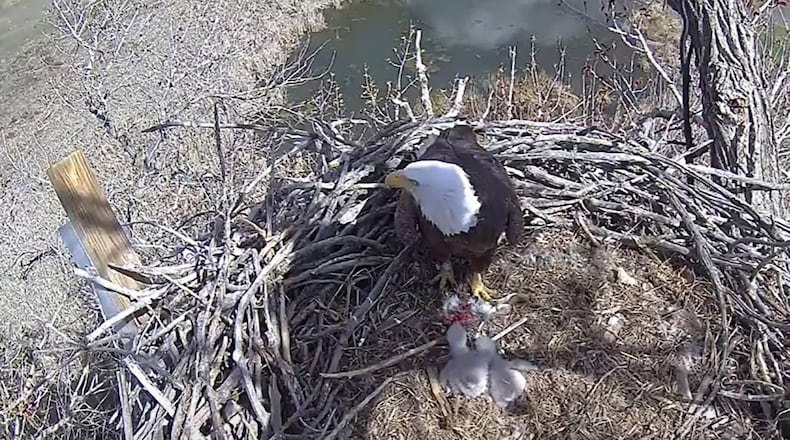State wildlife officials are breathing a sigh of relief after a survey of bald eagles showed a healthy nesting season, including along Georgia’s coast, where bird flu took a heavy toll on the animals’ reproduction last year.
The bald eagle, a national symbol, came close to extinction 50 years ago but has since rebounded following the ban of DDT pesticide and protections introduced under the Clean Water, Clean Air and Endangered Species Acts.
Survey leader Bob Sargent of the state Department of Natural Resources called the raptors’ comeback a great success, but warned that bird flu continues to pose a threat.
“A wildlife pandemic could rapidly turn around the enormous gains,” Sargent said. “That just supports the importance of continued, proactive conservation efforts to protect the species.”
This year, 232 eagles fledged, a rate of about 1.6 young per nest, which is slightly more than the state’s long-term average, DNR said.
In comparison, last year the state recorded 227 fledglings. Although there were a record number of active nest territories, many nests along the coast failed to produce fledglings, likely because of highly pathogenic avian influenza, commonly known as bird flu.
The virus at the center of the outbreak is the highly pathogenic strain of H5N1 bird flu. The variant has circulated globally for years, killing tens of millions of birds and causing millions more to be culled to prevent the spread. Infections in the U.S. among wildfowl, commercial chicken and turkey flocks have skyrocketed since early 2022.
Numerous species of wild mammals — such as bears, foxes and sea lions — have been reported and confirmed infected around the U.S. and other countries in recent months.
As of mid-June, nearly 7,100 cases in wild birds had been confirmed, with illness reported in every state but Hawaii.
Commercial poultry flocks in the U.S. have also been ravaged, with more than 58 million birds in 47 states killed by the virus or culled to prevent its spread. While several other southern states, including Tennessee, Mississippi and North Carolina have been affected, Georgia — which produces more broiler chickens than any other state — has not had a case in a commercial poultry facility during the current outbreak.
The virus typically infects wild waterfowl, migratory birds and shorebirds, and is spread through their feces and respiratory secretions.
In Georgia, bald eagles were likely infected by scavenging infected waterfowl carcasses, said David Stallknecht, a wildlife disease expert and professor emeritus of epidemiology at the University of Georgia. This year, that diseased food source appeared to be less of a problem.
“It’s good news,” Stallknecht said. “We really don’t know where this is going, but at least from what we have seen so far, it seems to be dependent on that waterfowl mortality, which we are not seeing right now.”
Controlling bird flu can be a challenge because it infects wild and domestic bird populations. The Atlanta-based Centers for Disease Control and Prevention says the virus is primarily a threat to wild birds, poultry and wild mammals. The agency said human infections are extremely rare.
Matthew Agvent, a spokesman for the Georgia Department of Agriculture, said the state has used strict biosecurity measures to prevent infections. The industry conducts roughly 1,110 tests each day for H5N1 in partnership with the Georgia Poultry Laboratory Network. Every commercial broiler flock in the state is tested before being processed, Agvent said, and egg-laying flocks are also tested every two to three months.
Last year, Georgia did have two outbreaks in backyard flocks that resulted in the deaths of 570 birds.
A total of 107 wild bird cases have been confirmed in Georgia since the current outbreak began, according to U.S. Department of Agriculture data. Most of those occurred in 2022 — so far this year, there have only been eight cases detected, with the most recent one occurring in April in a bald eagle found dead in Southwest Georgia.
The Georgia DNR says the public should keep an eye out for symptoms in birds of H5N1 infection, including lethargy, tremors and seizures. DNR has urged Georgians not to handle any birds or animals that are dead or suspected to be sick, and instead report them to the agency.
Hunters should also exercise caution when handling raw meat, and DNR says all game birds and poultry should be cooked thoroughly. While infections in dogs are rare, the agency said, dogs should be kept away from obviously sick or deceased birds and should not be allowed to eat raw game meat.
The public is also encouraged to report eagle nests via the state website to help track the birds’ population. They can do so at www.georgiawildlife.com/conservation/eaglenest or by calling 478-994-1438 or emailing bob.sargent@dnr.ga.gov.
Keep Reading
The Latest
Featured





